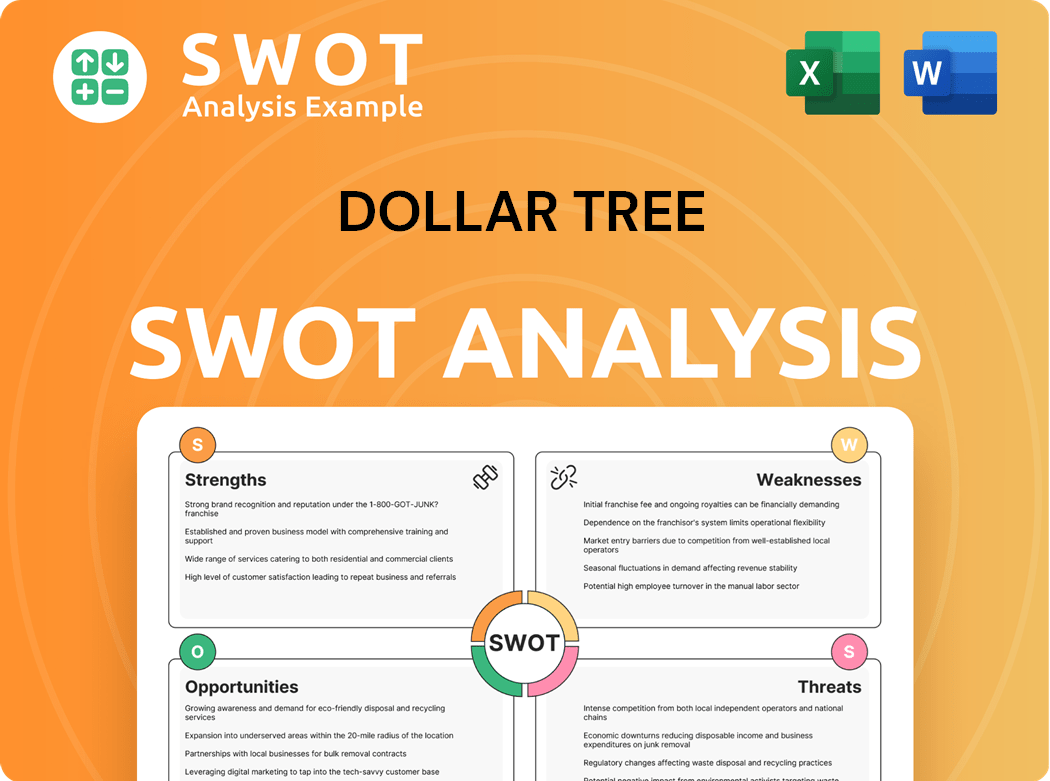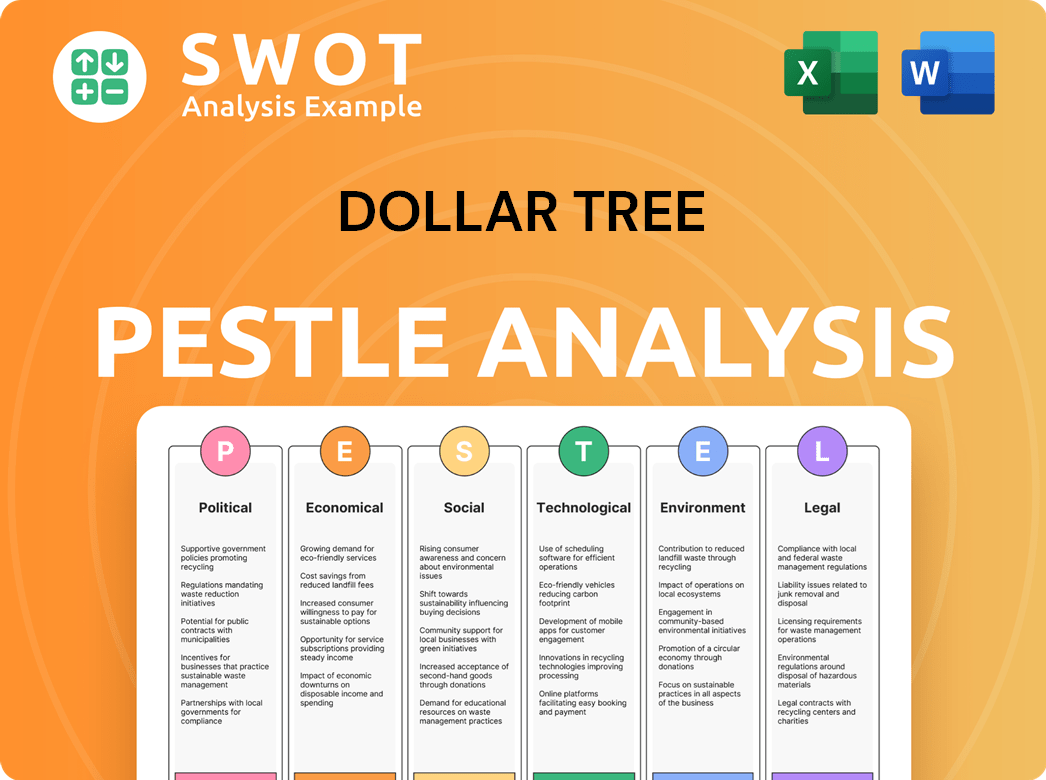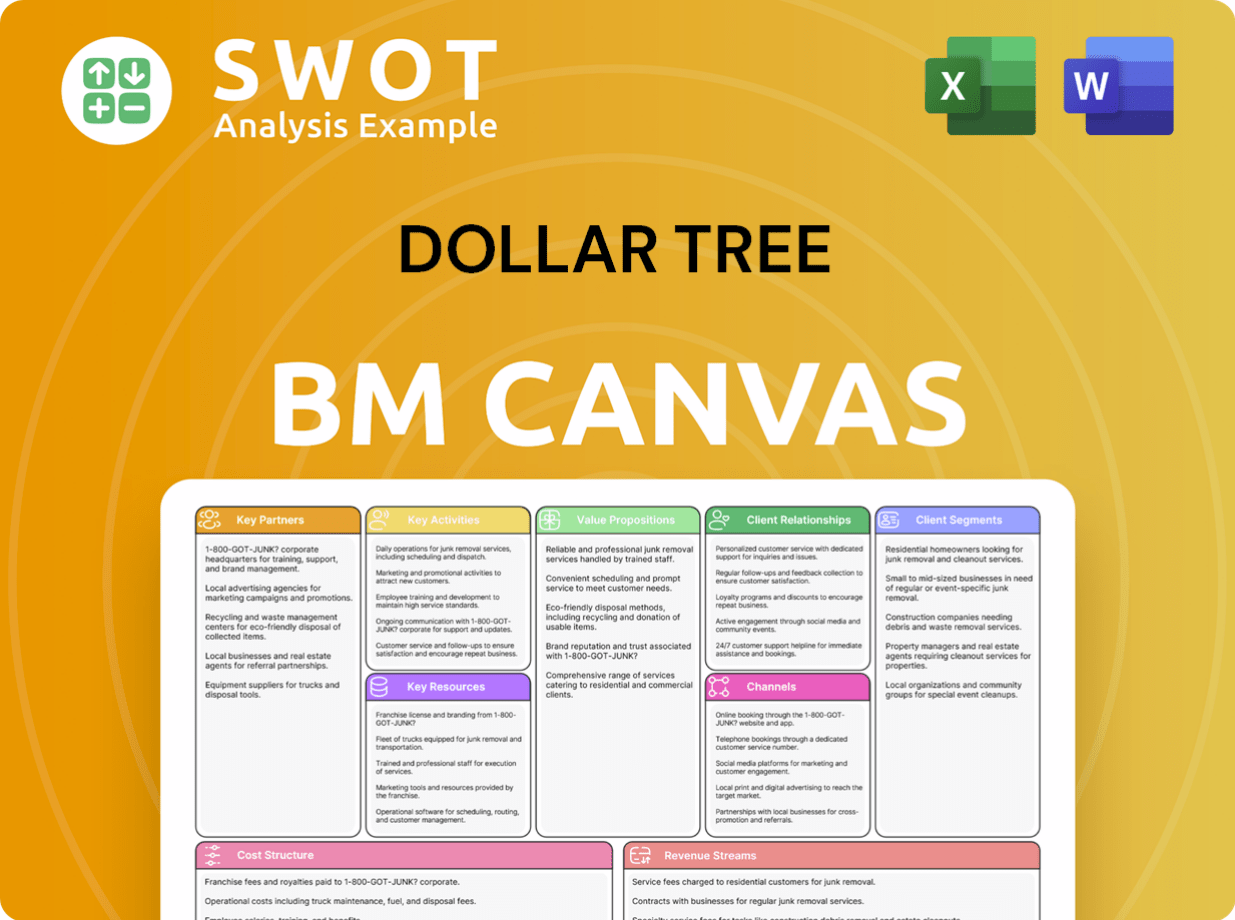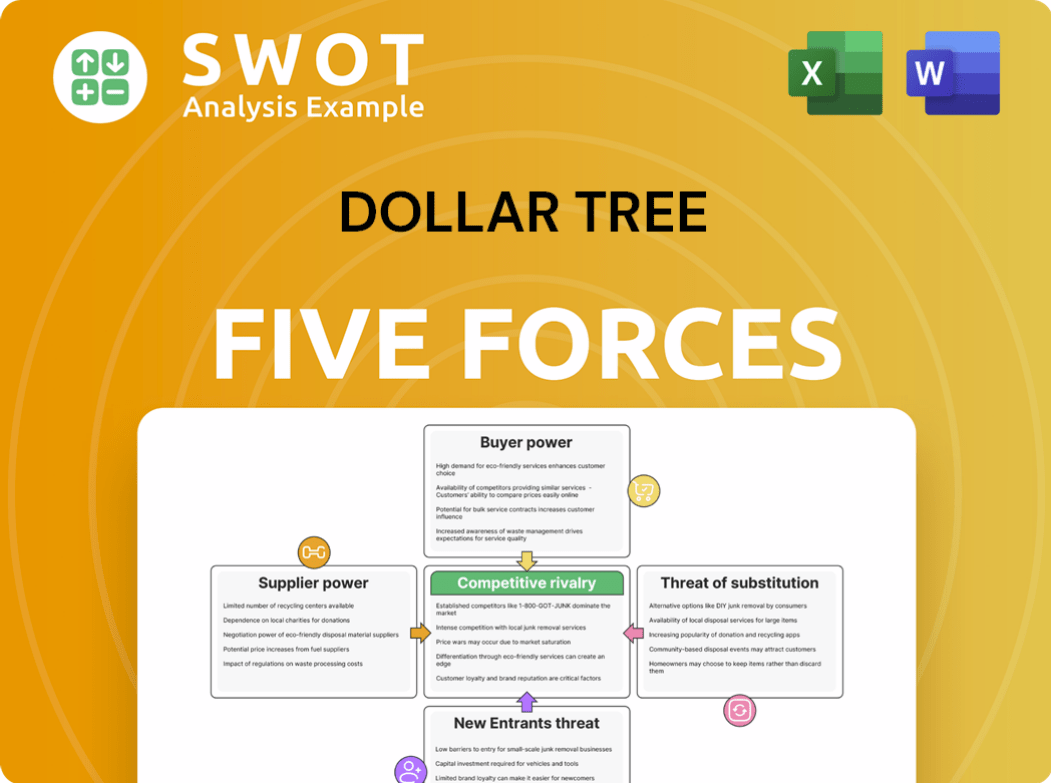Dollar Tree Bundle
Can Dollar Tree's Strategic Shift Redefine Discount Retail Dominance?
Dollar Tree, a retail giant, is currently undergoing a significant transformation with the divestiture of Family Dollar, a move designed to sharpen its focus on its core brand. Founded in 1986, the company has grown into a Fortune 500 powerhouse, operating over 16,000 stores across North America. This strategic realignment is a pivotal moment, signaling a new chapter for the discount retailer.

This Dollar Tree SWOT Analysis provides a comprehensive overview of the company's strategic direction, detailing its expansion plans and evaluating its financial performance. The company's future prospects hinge on its ability to navigate the evolving retail landscape, manage its supply chain challenges, and capitalize on its competitive advantages. Understanding the Dollar Tree business model and its impact on the retail industry is crucial for investors and business strategists alike, making this analysis essential for informed decision-making.
How Is Dollar Tree Expanding Its Reach?
The expansion initiatives of the company are primarily focused on optimizing its store portfolio and enhancing its core brand. A key component of this strategy includes the ongoing rollout of its '3.0 multi-price format' stores. This approach is a direct response to rising costs and inflation, enabling the company to maintain profitability while still offering perceived value to customers. The company's strategy also involves acquiring high-quality retail locations in priority markets to fuel growth.
These initiatives are designed to attract new customers, diversify revenue streams, and stay ahead of industry shifts. The expanded assortments in the 3.0 stores have already demonstrated a positive impact, with a notable increase in comparable store sales. The company's approach to expansion and its ability to adapt to market dynamics are crucial for its future prospects and overall growth strategy.
The company's focus on strategic acquisitions and the enhancement of its store formats highlights its commitment to long-term growth and its ability to adapt to the changing retail landscape. This approach is crucial for maintaining its market share and competitive advantages in the discount retail sector.
By the end of fiscal 2024, approximately 2,900 Dollar Tree 3.0 stores were operational, including 2,600 conversions and 300 new stores. The company aims to increase this to roughly 5,200 3.0 stores by the end of fiscal 2025, with plans for 2,000 new conversions and 300 new store openings. This format offers items priced between $3 and $7.
In May 2024, the company acquired designation rights for 170 leases of 99 Cents Only Stores across Arizona, California, Nevada, and Texas. This acquisition is a significant step in expanding its footprint in the western United States. The company continues to look for opportunities to grow through strategic acquisitions and mergers.
The company plans to roll out more hybrid stores in 2025, blending elements of Dollar Tree and Family Dollar. These stores will offer broader selections, more frozen foods, and convenience-driven layouts. This strategy aims to enhance the value proposition and attract a wider customer base.
The expanded assortments in 3.0 stores have already demonstrated a 220-basis-point comparable store sales lift compared to other formats. This lift is driven by a 20-basis-point traffic lift and a 200-basis-point ticket lift. This data highlights the impact of the multi-price strategy on financial performance.
The company's growth strategy is multifaceted, focusing on store format innovation, strategic acquisitions, and enhanced customer offerings. These initiatives are designed to drive sales growth and improve the overall customer experience. The company’s commitment to value and convenience is a key driver of its success, as highlighted in Mission, Vision & Core Values of Dollar Tree.
- Rollout of Dollar Tree 3.0 stores with multi-price points.
- Acquisition of 99 Cents Only Stores leases.
- Introduction of hybrid stores combining Dollar Tree and Family Dollar formats.
- Focus on expanding product assortments and improving store layouts.
Dollar Tree SWOT Analysis
- Complete SWOT Breakdown
- Fully Customizable
- Editable in Excel & Word
- Professional Formatting
- Investor-Ready Format

How Does Dollar Tree Invest in Innovation?
The company is actively leveraging technology and innovation to fuel its sustained growth, particularly through its digital transformation and operational enhancements. This approach is central to the overall Dollar Tree growth strategy, ensuring it remains competitive in the evolving retail landscape. The company's strategic focus includes continuous investment in its store footprint and supply chain network, which inherently involves technological advancements.
While specific details on R&D investments or cutting-edge technologies like AI or IoT are not extensively disclosed in recent reports, the emphasis on modernizing its store formats, such as the 3.0 model, suggests an underlying technological integration to enhance the customer experience and operational efficiency. These upgrades include wider aisles, better signage for easier navigation, clearly labeled multi-price sections, and expanded shelf space for frozen and refrigerated goods, all of which rely on improved store design and potentially integrated systems.
Furthermore, the company's efforts to improve its distribution centers and supply chain efficiency indicate an investment in logistics technology and automation. For instance, the company has taken mitigation actions related to tariffs, which could involve technological solutions for optimizing sourcing and inventory management. The shift to a multi-price strategy also necessitates more sophisticated point-of-sale systems and inventory management tools to handle varied pricing and product assortments effectively. These operational and store-level enhancements contribute directly to growth objectives by improving customer satisfaction and streamlining internal processes.
The company is focused on digital transformation to improve customer experience and operational efficiency. This involves integrating technology into store formats and supply chain management. The company is likely investing in e-commerce to enhance its online presence.
Upgrading store layouts, such as the 3.0 model, includes wider aisles and improved signage. These enhancements aim to improve navigation and shopping experience. There's an expansion of shelf space for refrigerated and frozen goods.
The company is focused on improving distribution centers and supply chain efficiency. This includes investments in logistics technology and automation. It involves technological solutions for optimizing sourcing and inventory management.
The shift to a multi-price strategy requires advanced POS and inventory tools. These tools are essential for managing varied pricing and product assortments. This strategy directly impacts the company's financial performance.
Enhancements at the operational level are critical for growth objectives. These improvements contribute to better customer satisfaction. Streamlining internal processes is a key focus.
Technology is integrated into store design and layout. This includes improved store design and potentially integrated systems. The company is investing in technologies to mitigate tariff impacts.
The company's approach to innovation and technology is multifaceted, focusing on both customer-facing improvements and back-end operational efficiencies. These initiatives are crucial for the Dollar Tree future prospects and maintaining its market share in a competitive retail environment. The company's strategic investments in technology are designed to enhance various aspects of its business model, from supply chain management to in-store experiences.
- Store Layout and Design: The implementation of the 3.0 store model exemplifies the company's commitment to enhancing the shopping experience. These stores feature wider aisles, improved signage, and expanded shelf space for refrigerated and frozen goods. This design is supported by integrated systems that streamline operations and improve customer navigation.
- Supply Chain and Logistics: The company is investing in technology to optimize its supply chain. This includes solutions for inventory management and mitigation of tariff impacts. These efforts are crucial for improving efficiency and reducing costs.
- Point-of-Sale (POS) Systems: With the introduction of a multi-price strategy, the company needs sophisticated POS systems. These systems are essential for managing varied pricing and product assortments effectively.
- E-commerce and Digital Initiatives: While specific details are limited, the company likely invests in e-commerce to enhance its online presence. This is a critical component of its digital transformation strategy.
For more insights into the financial aspects and strategic direction of the company, consider exploring the perspectives of Owners & Shareholders of Dollar Tree.
Dollar Tree PESTLE Analysis
- Covers All 6 PESTLE Categories
- No Research Needed – Save Hours of Work
- Built by Experts, Trusted by Consultants
- Instant Download, Ready to Use
- 100% Editable, Fully Customizable

What Is Dollar Tree’s Growth Forecast?
The financial outlook for the company in fiscal year 2025, based on continuing operations (excluding Family Dollar), anticipates net sales between $18.5 billion and $19.1 billion. This projection is supported by a comparable store net sales growth expectation of 3% to 5%. This signifies a continued growth trajectory from the $17.6 billion in net sales achieved in fiscal 2024 for continuing operations.
Adjusted diluted earnings per share (EPS) from continuing operations for fiscal 2025 are forecasted to range from $5.00 to $5.50. This forecast includes a negative impact of approximately $0.30 to $0.35 due to the half-year benefit from the Family Dollar Transition Services Agreement (TSA), with the majority of this impact concentrated in the initial two quarters of the fiscal year. These figures provide insights into the company's anticipated financial performance and its competitors landscape.
For the first quarter of fiscal 2025, net sales from continuing operations are expected to be between $4.5 billion and $4.6 billion, with adjusted diluted EPS ranging from $1.10 to $1.25. The company reported a gross profit margin of 35.81% for the quarter ending January 31, 2025. The company anticipates a slight improvement in gross margin for fiscal 2025, attributed to measures taken to address implemented tariffs.
Selling, general, and administrative (SG&A) expenses as a percentage of total revenue were 27.5% in fiscal 2024. A deleverage of approximately 50-80 basis points is expected in fiscal 2025 due to increased store payroll and state-mandated minimum wage increases.
Capital expenditures are projected to be between $1.2 billion and $1.3 billion in fiscal year 2025. This includes plans for approximately 400 new store openings, reflecting the company's expansion plans for 2024.
The sale of Family Dollar is anticipated to generate approximately $800 million in net proceeds. These funds will strengthen the balance sheet and provide liquidity for strategic initiatives, impacting the company's long-term investment potential.
Dollar Tree Business Model Canvas
- Complete 9-Block Business Model Canvas
- Effortlessly Communicate Your Business Strategy
- Investor-Ready BMC Format
- 100% Editable and Customizable
- Clear and Structured Layout

What Risks Could Slow Dollar Tree’s Growth?
The path forward for Dollar Tree, including its Dollar Tree growth strategy, faces several challenges. The retail landscape is intensely competitive, with rivals like Walmart and Dollar General vying for market share. Furthermore, economic shifts and consumer spending habits, particularly among low-income shoppers, can significantly impact sales and overall Dollar Tree financial performance.
Supply chain vulnerabilities and rising costs also pose risks. The company sources a significant portion of its merchandise from direct imports, mainly from China, making it vulnerable to tariffs and trade restrictions. Operational issues, such as rising expenses and increased markdown costs, have also pressured operating margins. The strategic review and sale of Family Dollar, while aimed at long-term improvement, present near-term challenges such as the burden of shared-service expenses in the first half of fiscal 2025.
Attracting and keeping skilled employees to support strategic initiatives and system improvements also poses a risk. Management actively assesses and prepares for these risks through diversification, strategic adjustments, and ongoing operational improvements, aiming to navigate the complexities of the retail sector and maintain a positive outlook for Dollar Tree future prospects.
The discount retail sector is highly competitive, with players like Walmart, Dollar General, and online retailers vying for market share. This intense competition affects pricing, merchandise quality, assortment, and customer service, impacting the Dollar Tree business model.
A significant portion of Dollar Tree's merchandise comes from direct imports, primarily from China, exposing it to tariffs and trade restrictions. This reliance can lead to increased costs and potential margin pressures, influencing the Dollar Tree stock forecast.
Economic fluctuations and changes in consumer spending habits, especially among low-income customers, can significantly impact sales. Inflation and higher living costs can reduce the purchasing power of Dollar Tree's core customer base, affecting Dollar Tree same-store sales trends.
Operational difficulties, including unfavorable shrink results, rising distribution and merchandising expenses, and increased markdown costs, can pressure operating margins. These factors can impact the Dollar Tree profitability analysis.
The strategic review and sale of Family Dollar, while aimed at long-term gains, present near-term challenges like shared-service expenses. This can affect the company's financial performance in the short term, influencing Dollar Tree mergers and acquisitions.
Attracting and retaining skilled employees to support strategic initiatives and system improvements is a risk. This can impact the company's ability to execute its plans and maintain its competitive edge, affecting Dollar Tree expansion plans 2024.
The discount retail market is highly competitive, with established players and emerging online retailers constantly vying for market share. This competition puts pressure on pricing, product quality, and customer service, which can impact Dollar Tree's Dollar Tree competitive advantages. The company must continually innovate to maintain its position.
Dollar Tree's reliance on imports, particularly from China, makes it vulnerable to tariffs, trade restrictions, and fluctuating shipping costs. Any disruption in the supply chain can lead to increased costs and decreased profitability, affecting the Dollar Tree supply chain challenges. Diversifying sourcing and optimizing logistics are crucial.
Economic downturns and changes in consumer spending habits can significantly impact Dollar Tree's sales. Low-income consumers, who are a significant portion of the customer base, are particularly vulnerable to economic pressures. Understanding the Target Market of Dollar Tree is crucial for adapting to changing economic conditions.
Internal operational issues, such as managing expenses, controlling shrink, and ensuring store safety, can negatively impact profitability. Effective cost management and operational efficiency are essential for maintaining a competitive edge and achieving a positive Dollar Tree long-term investment potential.
Dollar Tree Porter's Five Forces Analysis
- Covers All 5 Competitive Forces in Detail
- Structured for Consultants, Students, and Founders
- 100% Editable in Microsoft Word & Excel
- Instant Digital Download – Use Immediately
- Compatible with Mac & PC – Fully Unlocked

Related Blogs
- What are Mission Vision & Core Values of Dollar Tree Company?
- What is Competitive Landscape of Dollar Tree Company?
- How Does Dollar Tree Company Work?
- What is Sales and Marketing Strategy of Dollar Tree Company?
- What is Brief History of Dollar Tree Company?
- Who Owns Dollar Tree Company?
- What is Customer Demographics and Target Market of Dollar Tree Company?
Disclaimer
All information, articles, and product details provided on this website are for general informational and educational purposes only. We do not claim any ownership over, nor do we intend to infringe upon, any trademarks, copyrights, logos, brand names, or other intellectual property mentioned or depicted on this site. Such intellectual property remains the property of its respective owners, and any references here are made solely for identification or informational purposes, without implying any affiliation, endorsement, or partnership.
We make no representations or warranties, express or implied, regarding the accuracy, completeness, or suitability of any content or products presented. Nothing on this website should be construed as legal, tax, investment, financial, medical, or other professional advice. In addition, no part of this site—including articles or product references—constitutes a solicitation, recommendation, endorsement, advertisement, or offer to buy or sell any securities, franchises, or other financial instruments, particularly in jurisdictions where such activity would be unlawful.
All content is of a general nature and may not address the specific circumstances of any individual or entity. It is not a substitute for professional advice or services. Any actions you take based on the information provided here are strictly at your own risk. You accept full responsibility for any decisions or outcomes arising from your use of this website and agree to release us from any liability in connection with your use of, or reliance upon, the content or products found herein.